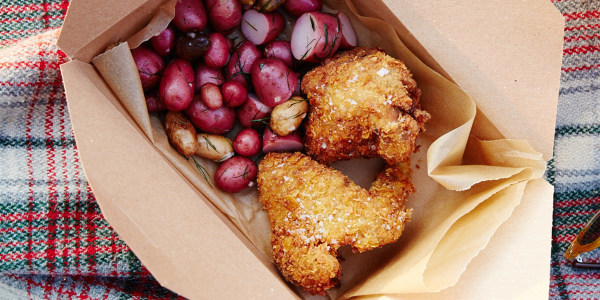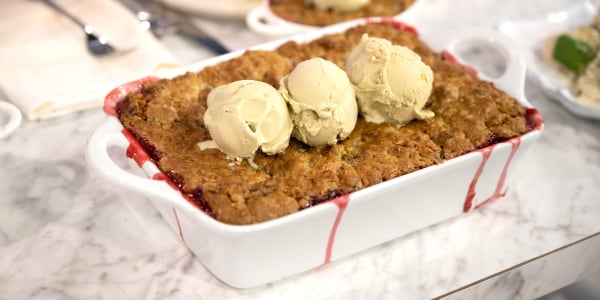With its bright red color and natural tartness, rhubarb isn't always a vegetable we reach for first. But, especially when paired with sweeter fruits, this stalk can be a delicious way to get a boost of some important nutrients, dietitians say.
Rhubarb has a long history of traditional medicinal uses, says registered dietitian Grace Derocha. It's also technically listed as a fruit by the U.S. Department of Agriculture, she notes, a quirk that dates back to a 1947 customs decision made for "tariff reasons," according to the Smithsonian.
Whether you think of it as a fruit, vegetable or simply pie filling, rhubarb packs some helpful nutrients in a colorful, low-calorie package.
"Though it's not especially rich in essential nutrients, it does have a lot of bang for your nutritional buck there," Shelly Wegman, a registered dietitian with UNC Rex Nutrition Services, tells TODAY.com.
"It's an excellent source of vitamin K, and it's high in fiber, similar to an apple, orange or celery," she notes. Rhubarb also contains some healthy plant compounds, including anthocyanins and resveratrol, the experts say.
Rhubarb Nutrition
A cup of chopped rhubarb contains:
- 26 calories
- 1 gram of protein
- 6 grams of carbohydrates
- 2 grams of fiber
- 1 gram of sugar
- 36 micrograms of vitamin K (40% daily value)
- 10 milligrams of vitamin C (13% daily value)
Rhubarb Health Benefits
While low in calories and carbohydrates, rhubarb is "definitely rich in fiber," Derocha says, which has benefits for gut health as well as heart health and blood sugar management.
Rhubarb is quite rich in vitamin K, Wegman notes, which plays an important role in proper blood clotting. Vitamin K also promotes the "formation and strengthening of bones," she says, and "helps limit neuron damage in the brain."
While people on blood thinners need to monitor how much vitamin K they eat, everyone needs some vitamin K in their diets.
Additionally, rhubarb contains a bit of beta-carotene, which the body converts to vitamin A, Wegman explains, and vitamin C, which plays a role in immunity and many other bodily processes.
Rhubarb is also surprisingly high in electrolyte minerals, Derocha says, including calcium, potassium and magnesium. These are essential for proper hydration and maintaining the delicate balance of fluid pressure in and around your cells.
Finally, as you might guess from its vibrant color, rhubarb packs an "antioxidant punch," notes Derocha, who is also a spokesperson for the Academy of Nutrition and Dietetics. It contains anthocyanins, which contribute to the color, as well as polyphenols.
These anti-inflammatory compounds "protect cells and reduce oxidative stress," Derocha explains, which has benefits for metabolic health and the management of chronic diseases, such as Type 2 diabetes.
Rhubarb also contains the polyphenol resveratrol, “which contributes to regulating fat metabolism and lowering cholesterol,” Wegman notes, adding that it’s also famously found in red grapes.
Can You Eat Rhubarb Leaves?
As tempting as it might be, you should not eat rhubarb leaves, Derocha says.
The leaves of the rhubarb plant contain a particularly high amount of oxalates, the USDA notes, which can be toxic.
"The leaves can make you very sick, so you have to be very careful about that," Wegman cautions.
Additionally, anyone with a history of kidney stones needs to be careful with rhubarb — including the stalk — due to the presence of calcium oxalate, Wegman says. This compound can make certain types of kidney stones more likely.
Cooking the rhubarb does help break down some of those oxalates, Derocha says, but doesn't eliminate them entirely.
Best Ways to Cook With Rhubarb
Because rhubarb tends to be tart, it's often paired with sweeter foods, especially strawberry.
That tartness also naturally lends itself to sweetened desserts, like pies, crisps and crumbles, Derocha says. She's also a fan of rhubarb jam with strawberries and chia seeds, as well as a rhubarb barbecue sauce over ribs or chicken.
Rhubarb can also be included in salads or salad dressing, Wegman notes, especially when paired with fruit like strawberries or raspberries.
But Derocha also likes to roast rhubarb with a simple mix of spices, lemon or orange zest and vanilla extract. She then uses the mixture as a topping for Greek yogurt, chia seed pudding or overnight oats, while her kids like it on pancakes.
"It adds a different texture and flavor that doesn't come with a lot of sugar," Derocha says.











 English (US) ·
English (US) ·